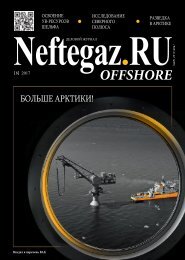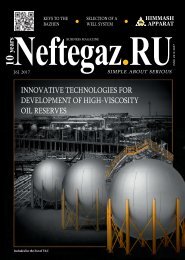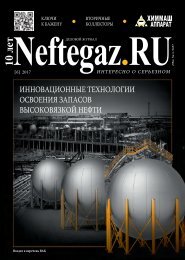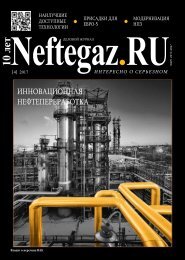Neftegaz.RU #3-17 ENG
You also want an ePaper? Increase the reach of your titles
YUMPU automatically turns print PDFs into web optimized ePapers that Google loves.
OFS<br />
inhibitor injection. Mutual solvents<br />
(WAW85202 (Baker Petrolite),<br />
ВР-1 (Experimental plant<br />
NefteHim and others) or nonionic<br />
or cation-active surfactant water<br />
solutions are used as liquid mud.<br />
Injection is performed with<br />
maximum flow rate of injected<br />
mutual solvent without hydraulic<br />
fracture in the following sequence:<br />
• cementing unit AC-32 (CA-320),<br />
[АЦ-32 (ЦА-320)], is connected<br />
to the well tube side for injection<br />
of the solution;<br />
• when casing valve is opened,<br />
the required volume of liquid<br />
mud is injected by means of acid<br />
pumping unit. When casing valve<br />
is opened, there will occur only<br />
the borehole cleanout without<br />
affecting the formation;<br />
• delivery of the main volume of<br />
inhibitor is performed by injection<br />
of the inhibitor (lacking volume<br />
after the mutual solvent injection<br />
for displacement of well-killing<br />
fluid from the tubing), it is injected<br />
when casing valve is opened in<br />
order to fill the remaining voidage<br />
of the tubing. Then the injection<br />
is stopped, the valve is closed<br />
and the remaining solution pills in<br />
required volume are injected into<br />
the formation. The 10% inhibitor<br />
solution is used (depending on<br />
the predicted protective effect).<br />
The injection is carried out using<br />
the same unit with maximum flow<br />
rate without hydraulic fracture;<br />
• delivery of the overflush fluid<br />
volume is carried out in order to<br />
push the inhibitor deeper into<br />
the formation. For displacement<br />
of inhibitor solution it is<br />
recommended to use 2% KCl<br />
solution, when injecting water<br />
solution of inhibitor and degassed<br />
oil, when injecting organic<br />
inhibitor solution. The injection<br />
is carried out, when the casing<br />
valve is closed, with maximum<br />
flow rate without hydraulic<br />
fracture.<br />
• response – the well is shut in<br />
for 12 – 24 hours, all works are<br />
suspended in order for corrosion<br />
inhibitor to be adsorbed on the<br />
reservoir formation;<br />
• technological tubing is pulled out<br />
and underground equipment is<br />
lowered;<br />
• well is put into run, then it is put<br />
into operation.<br />
Required quantity of mutual solvent<br />
is calculated by the following<br />
equitation:<br />
where – volume of mutual<br />
solvent for formation washing, m 3 ,<br />
– penetrated-formation<br />
thickness, m.<br />
When the bottom-hole formation<br />
zone is used as a natural dosing<br />
unit, then the empirical rule of "onethird"<br />
is working (same as when<br />
applying salt inhibitors) [2]. This<br />
rule is as follows: the third part of<br />
corrosion inhibitor injected in the<br />
formation is irrevocably adsorbed<br />
on the deposit rock (during the first<br />
few treatments); the third part of<br />
corrosion inhibitor injected in the<br />
formation is subtracted during the<br />
first few days (from 3 to 15) after<br />
start of well performance; and only<br />
the remaining third part of corrosion<br />
inhibitor injected in the formation is<br />
being subtracted for long period of<br />
time.<br />
Therefore, calculation of corrosion<br />
inhibitor weight for injection in<br />
the bottom-hole formation zone<br />
is carried out using the following<br />
formula:<br />
where – concentration of this<br />
corrosion inhibitor in produced fluid<br />
that provide the required protective<br />
effect in the system or corrosion<br />
coupon, mg/l (approximately<br />
g/t); – fluid mass flow rate,<br />
m 3 /d (approximately t/d); –<br />
estimated time of corrosion inhibitor<br />
subtraction from the formation, d;<br />
1,000 – factor for conversion of<br />
grams into kilograms; 3 – coefficient<br />
of "one-third" rule.<br />
Overflush fluid volume , m 3 , is<br />
calculated by the following formula:<br />
where – effective formation<br />
porosity, unit fraction; – internal<br />
radius of ingress of burned inhibitor<br />
solution in the formation, m. It is<br />
taken as 1.5 – 2.0 m and is specified<br />
based on the results of observation<br />
over the duration of reagent<br />
subtraction; – formation<br />
thickness, m; – tubing volume,<br />
m 3 ; – volume of production casing<br />
from pump suction or tubing intake<br />
to bottom perforations, m 3 ; = 3,14.<br />
If well-killing fluid volume is 130 m 3 ,<br />
then overflush fluid volume will be<br />
0,2 · 3,14 · 1,5 2 · 500 + 130= 840 m 3 ; in<br />
this case the well protection time will<br />
be not less than 365 days.<br />
When installing the block-pills, the<br />
squeezing process is carried out till<br />
their installation by squeezing the<br />
reagent through the tubular annulus.<br />
Technology of intermittent<br />
dosing of inhibitor into the<br />
casing annulus<br />
Technology of well treatment using<br />
the method of intermittent injection<br />
of corrosion inhibitor solution into<br />
the casing annulus is simpler<br />
compared to the technology of<br />
inhibitor solution injection into<br />
the bottom-hole formation zone<br />
described above. Partly therefore,<br />
the method of inhibitor injection<br />
into the casing annulus is more<br />
common. Corrosion inhibitor is<br />
delivered to casing annulus in form<br />
of 10% solution in oil or water.<br />
The advantage of this technology<br />
compared to the technology of<br />
inhibitor solution injection into the<br />
bottom-hole formation zone is that<br />
batch treatments can be carried out<br />
during well operation, and not only<br />
when the wells are being serviced.<br />
The disadvantage of this technology<br />
is the necessity of more frequent<br />
(in average 1 time per 30 days)<br />
treatments [3].<br />
The technology of intermittent<br />
dosing of inhibitor into the casing<br />
annulus solves the following main<br />
problems:<br />
• protection of well underground<br />
equipment against corrosion with<br />
time between repairs of more than<br />
60 – 150 days.<br />
• protection of working level casing<br />
column against corrosion;<br />
• corrosion inhibitor saving (due to<br />
the absence of required adsorption<br />
on the deposit rock).<br />
30 ~ <strong>Neftegaz</strong>.<strong>RU</strong> [3]














